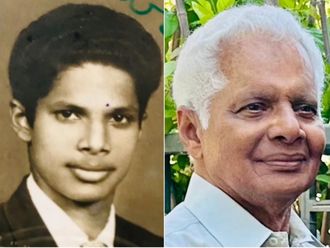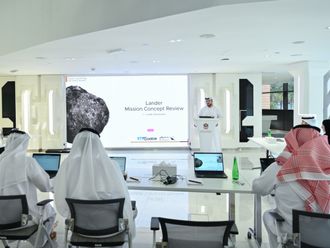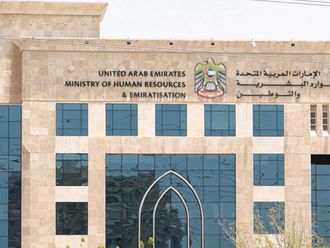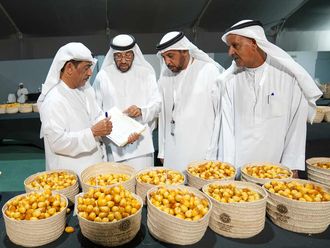A work in mosaic is being installed at the Dubai Development Board, portraying the city as it was and as it is
In October 2002, Mosaika Art & Design, a Canadian-based company founded by Saskia Siebrand and Kori Smyth, participated at the Index Show in Dubai. It was at this show that Mosaïka introduced its unique design approach of large-scale custom mosaic works to the Middle Eastern market.
During the exhibition, Mosaika came to the attention of architect Camran Yaghmai of Casa Mia, Dubai. He approached Saskia to discuss the creation of a large-scale wall mosaic for the entrance mezzanine of the Dubai Development Board Headquarters. Subsequently, design prototypes were developed through correspondence and two months later the final design was selected and approved.
Today Saskia, together with Mosaikas's installation supervisor and top artisan, Michael Minnis, are on the verge of completing the installation of the artwork aptly titled – Dubai Cityscape – Old & New at the development board's headquarters.
It was to view this installation that I walked into the building, and was greeted with the sight of Saskia and Michael, both standing atop the scaffolding, busy fixing what looked like the biggest jigsaw puzzle I had ever seen.
"I have tried to give it to other people to do, but after so much work has gone in, I get so concerned that something is going to go wrong with the installation that I prefer to do it myself. It makes me sleep better," said Saskia.
For one who is unfamiliar with the minutiae of mosaic work, witnessing the putting together of a piece of dimensions 485cm by 366cm came across as a complex task. Small individual blocks had been numbered for identification and were being intricately glued together. The mural, which had started as a mélange of more than a dozen colours, soon formed a picture right in front of the eyes. A picture that said many things about Dubai – the city it was and the city it is.
Camran Yaghmai, responsible for most of the architecture of the development board building, acted as a liaison between Mosaika and the development board management. "The concept of the development board is to develop the country. So we picked Dubai as a topic, and showcased how it has grown immensely in the architectural and building division," he explained
"The concept was specific – new Dubai growing out of the old Dubai. Those were basically the parameters that I had to work with," said Saskia. "We have made an arched window in the design. We wanted it to look like a vista looking out into the future and we wanted it to have some depth. The idea was of a very intricate old brick structure and then we contrasted it with the very sleek modern shapes of the Dubai buildings."
The final design is a fantastic vista, juxtaposing the architectural landmarks of both ancient and modern Dubai as seen through an Islamic-inspired portal in the foreground. Visually anchored by the intricate mosaic detailing of Dubai's historic old town, the architectural structures of Dubai's ultra modern skyscrapers rise majestically above the horizon.
In simpler terms, the design showcases the high-rise buildings of Dubai as if one is looking through an old brick arched window, with a slightly bent branch of a palm tree falling across the view.
The actual production of the mosaic began in January this year. Throughout the mosaic, various cut-tile styles were employed to create a sophisticated true-to-life rendition of the design. Over the course of two months, a team of 12 artisans worked on smaller sections whereby each piece of mosaic was individually hand cut for a perfect fit. Once the sections were completed, they were assembled to create the final mosaic as a whole.
"There were hundreds of colours that had to be glazed for this because there are some very subtle gradations running up the side," Saskia explained. "We have treated each section differently. Because we were working with whole tiles that were six by six inches we were able to cut all the shapes depending on the treatment of the area. Shapes for the water, sky, the new and the old town have all been cut differently, not in squares. This creates something a little bit more vibrant, more alive."
In preparation for shipping, the final mosaic was cut into manageable sections to be later re-assembled like a jigsaw puzzle on site in Dubai. A temporary adhesive film on the tile surface secured each piece in place until it was ready to be installed onto the wall itself.
The actual installation takes a week. Two days of gluing and putting the entire sections in; another 24 to 48 hours are given to let the glue dry and then comes the final grouting in the crevices and cleaning of tiles. The mosaic is on schedule to be finished by Saturday.
"The mural was a challenge. When you have a project like this, it is sometimes difficult executing it. It is the first installation that we have done with the intention of moving it later. Usually we do permanent installations," said Michael who has been working for Mosaika for four years now.
"Mosaic is quite an intricate medium to work with. Each stage is challenging and engaging, as it requires a lot of decision-making. From the design to the production and installation, every step requires a lot of attention," he said. "Every piece that Mosaika has done so far is one-of-a-kind and custom-made. We have not duplicated any pieces. Each one has been designed for specific purposes. It is very satisfying working on these projects because it allows one to do unique art pieces.
"I joined Mosaika when the company was fairly new and have seen it grow and spread its wings into the international market. Currently we are working on a project for the New York subway. This is our introductory work in Dubai and we are looking forward to bigger projects, Dubai being the hub of some fabulous architectural structures," he added.
A mural with a view
In October 2002, Mosaika Art & Design, a Canadian-based company founded by Saskia Siebrand and Kori Smyth, participated at the Index Show in Dubai.











